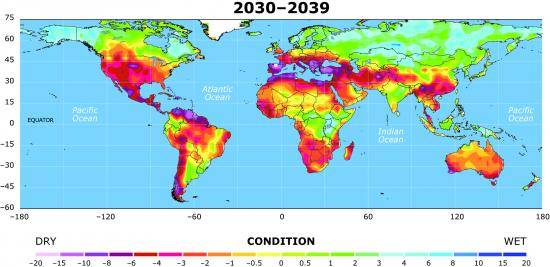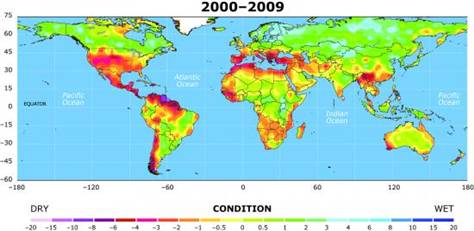
- Font:
- +
- -
Increasingly dry conditions across much of the globe — including the U.S. — are likely over the next 30 years, a new study predicts. Moreover, by the year 2100 drought in some regions could be unprecedented in modern times.
-
-
China's wealth gap strains social fabric
Updated 113 minutes ago 10/20/2010 2:36:34 PM +00:00 China’s economic boom has boosted incomes for urban residents, but rural households have largely been left behind. That wealth gap poses a China-sized problem for the country's leaders. Full story
- Iran: 2 detained Americans will face trial
- Updated 1 minutes ago 10/20/2010 4:28:29 PM +00:00 20-year-old student named police chief in Mexico town
- Updated 75 minutes ago 10/20/2010 3:13:58 PM +00:00 U.K. faces sharpest spending cuts since WWII
- Updated 42 minutes ago 10/20/2010 3:47:22 PM +00:00 One-in-four Afghan votes thrown out over fraud
-
China's wealth gap strains social fabric
Increasing drought has long been forecast as a consequence of warming temperatures, but the study from the National Center for Atmospheric Research projects serious impacts as soon as the 2030s. Impacts by century's end could go beyond anything in the historical record, the study suggests.
"We are facing the possibility of widespread drought in the coming decades, but this has yet to be fully recognized by both the public and the climate change research community," study author Aiguo Dai said in a statement. "If the projections in this study come even close to being realized, the consequences for society worldwide will be enormous."
To get an idea of how severe droughts might get, scientists use a measure called the Palmer Drought Severity Index, or PDSI. A positive score is wet, a negative score is dry and a score of zero is neither overly wet nor dry.
The most severe drought in recent history, in the Sahel region of western Africa in the 1970s, had a PDSI of -3 or -4.
By contrast, the study indicates that by 2100 some parts of the U.S. could see -8 to -10 PDSI, while Mediterranean areas could see drought in the -15 or -20 range.
"Historical PDSI for the last 60 years show a drying trend over southern Europe but nothing like those values at the end of this century," Dai said. "Decadal mean values of PDSI have not reached -15 to -20 levels in the past in any records over the world."
Newsweek reports on the race to buy up the world's waterBy the 2030s, the central and western U.S. could see average readings dropping to -4 to -6, the study projected.
Areas likely to experience significant drying include:
- the western two-thirds of the United States;
- much of Latin America, especially large parts of Mexico and Brazil;
- regions bordering the Mediterranean Sea;
- large parts of southwest Asia;
- southeast Asia, including China and neighboring countries;
- most of Africa and Australia.
While Earth is expected to get dryer overall, some areas will see a lowering of the drought risk. These include: much of northern Europe; Russia; Canada; Alaska; and some areas of the Southern Hemisphere.
That doesn't necessarily mean that agriculture will migrate from the drought areas to these places in the high latitudes, Dai wrote.
"The high-latitude land areas will experience large changes in terms of warmer temperatures and more precipitation, and thus may indeed become more habitable than today," he wrote. "However, limited sunshine, short growing season, and very cold nighttime temperature will still prevent farming over most of these high-latitude regions."

The study's findings are based on 22 computer models and the best current predictions of climate-warming greenhouse gas emissions. This could change depending on actual greenhouse emissions in the future as well as natural climate cycles such as El Nino, Dai said.
The study appears this week in the journal Wiley Interdisciplinary Reviews: Climate Change. It was supported by the National Science Foundation.
Reuters contributed to this report.








“
Despite the anti-intellectualism movement and conspiracy theories among conservatives, most won't deny climate change in the past and therefore in the future. What they don't believe is that it is caused by human activity. They don't want to create plan B or C because this would mean sincere research into cause, which may not support their position.
Also, I suspect some pre-destination among conservatives, more specifically the End of Times. So if we predict drought that just supports their religious beliefs. I will say it is interesting that 2050 is when Isaac Newton predicts the end, but why a person would not at least try to make a better world for future generations (their children) is beyond me.
”